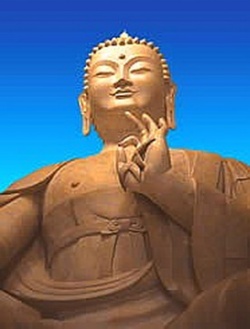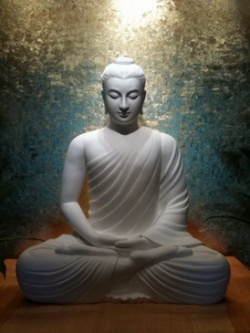Eight teachings
eight teachings
八教 ( Jpn hakkyo )
A system by which T'ient'ai (538-597) classified Shakyamuni's teachings. The eight teachings are divided into two groups: the four teachings of doctrine and the four teachings of method. The first is a division by content, and the second, by method of teaching. The four teachings of doctrine are:
(1) The Tripitaka teaching, which corresponds to Hinayana, is so called because it consists of the three divisions of the canon (Skt tripitaka )—sutras (the Buddha's teachings), vinaya (the rules of monastic discipline), and abhidharma (commentaries and treatises). The teachings of this category reveal the cause of transmigration in the threefold world and urge one to free oneself from this continual rebirth and enter the state of nirvana in which all desires are extinguished. To help one cast off attachment to the threefold world, they teach the analytical view of nonsubstantiality, or the perception that all things, when analyzed into their constituent elements (dharmas), prove to be without substance. These teachings were expounded primarily for persons of the two vehicles and secondarily for bodhisattvas.
(2) The connecting teaching, or introductory Mahayana, which is so called because it forms a link between the Tripitaka teaching and the specific teaching. Like the Tripitaka teaching, the connecting teaching is concerned with casting off attachment to the threefold world. The teachings of this category deny the view of the Tripitaka teaching that all things, when analyzed, prove to be without substance; instead they teach the view that all things, just as they are, are without substance, because they arise and disappear only by virtue of dependent origination.These teachings are directed primarily to bodhisattvas and secondarily to persons of the two vehicles.
(3) The specific teaching, or a higher level of provisional Mahayana, which is so called because it was expounded specifically for bodhisattvas. The teachings of this category set forth a long series of austere practices spanning many kalpas, which bodhisattvas must carry out to attain Buddhahood. They address the three truths of nonsubstantiality, temporary existence, and the Middle Way, but indicate them as separate from and independent of one another.
(4) The perfect teaching, which expounds the mutually inclusive relationship of the ultimate reality and all phenomena, and the unification of the three truths. The perfect teaching is directed to people of all capacities and holds that all can attain Buddhahood. According to T'ient'ai's system, the Tripitaka, connecting, and specific teachings are all means leading to the perfect teaching, which encompasses and unifies them.The four teachings of method is a classification of the teachings in terms of the way the Buddha taught them.They are
(1) The sudden teaching, or those teachings that Shakyamuni expounded directly from his own enlightenment without giving his disciples preparatory knowledge.This category corresponds to the Flower Garland Sutra, traditionally regarded as the first teaching he expounded after his enlightenment at Buddhagaya.
(2) The gradual teaching, or those teachings expounded to gradually elevate people's capacities to an understanding of higher doctrines.The gradual teaching corresponds to the sutras of the Agama, Correct and Equal, and Wisdom periods.
(3) The secret teaching, or those teachings that the listeners understand differently according to their respective capacities and from which they each receive a different benefit without being aware of the difference.
(4) The indeterminate teaching, or those teachings that the listeners understand and benefit from differently as above but are aware of the difference.See also five periods.

